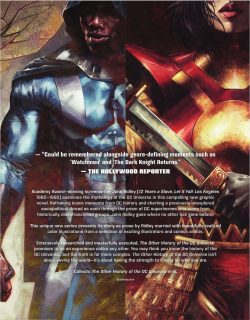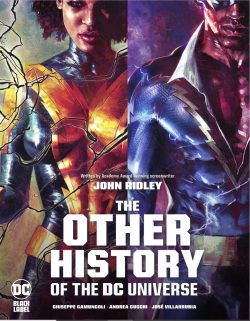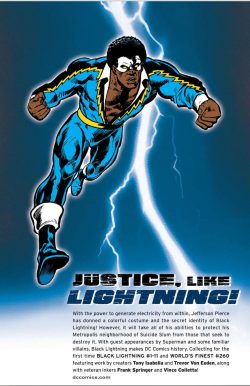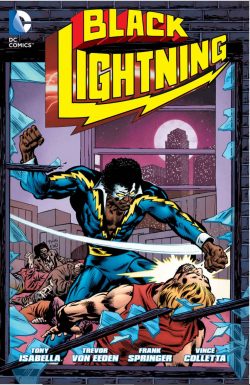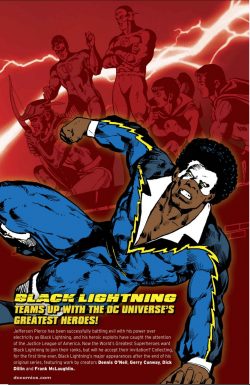
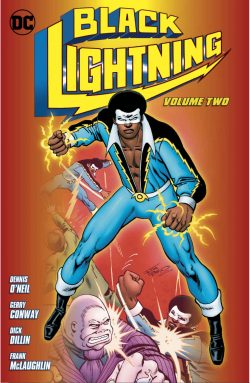
By Dennis O’Neil, Gerry Conway, J.M. DeMatteis, Martin Pasko, Paul Kupperberg, Dick Dillin, George Tuska, Rich Buckler, Marshall Rogers, Mike Netzer/Nasser, Romeo Tanghal, Joe Staton, Pat Broderick, Dick Giordano, Gerald Forton & various (DC Comics)
ISBN: 978-1-4012-7546-4 (TPB/Digital edition)
Black Lightning was the first African American superhero to have his own solo DC title. It launched in 1977 and ran for 11 issues.
When former Olympic decathlete Jefferson Pierce returned to the streets of Metropolis’ Suicide Slum to teach at inner city Garfield High School, he was determined to make a real difference to the disadvantaged and often troubled kids he used to be numbered amongst. However, when he interrupted a drug buy on school grounds and sent the dealer packing, he opened everyone around him to mob vengeance and personal tragedy…
When the ruling racketeers – an organised syndicate dubbed The 100 – came seeking retaliation, one of Pierce’s students paid the ultimate price. The traumatised teacher realised he needed the shield of anonymity if he was to win justice and safety for his beleaguered home and charges…
Happily, tailor Peter Gambi – who had raised Jefferson and taken care of his mother after the elder Pierce was murdered – had some useful ideas and inexplicable access to some pretty far-out technology. Soon, equipped with a strength-&-speed-enhancing forcefield belt and costume, plus a mask and wig that completely changed his appearance, a fierce new vigilante stalked the streets of Metropolis…
This second outing gathers a flurry of back-up and guest appearances from May 1979 to October 1980, garnered from various titles the urban avenger prowled in after his solo title folded. They cumulatively comprise World’s Finest Comics #256-259 and #261, DC Comics Presents #16, Justice League of America #173-174, Detective Comics #490-491, 495-495 and The Brave and the Bold #163 plus pertinent material from Who’s Who: The Definitive Directory of the DC Universe #3 (1985) and Who’s Who in the DC Universe #16 (1992).
Following an informative Introduction by character originator Tony Isabella reprising Black Lightning: The In-Between Years, the (relatively) down-to-earth superhero antics recommence in ‘Encounter with a Dark Avenger!’ (courtesy of Denny O’Neil, Dick Dillin & Frank Chiaramonte, as seen in World’s Finest Comics #256).
Here the electric warrior is manipulated into a potentially fatal confrontation with equally fervent urban vigilante Green Arrow. As the heroes clash, neither is aware the 100’s ousted boss Tobias Whale is behind their mutual woes…
That short yarn saw Black Lightning as GA’s guest star and served as a prelude to ‘Death Ransom!’ (WFC #257), beginning Pierce’s second (strictly backup) series. Crafted by O’Neil, George Tuska & Bob Smith, it sees a fateful, brutal clash with The Whale, resulting in a wary ceasefire for the archenemies as they unite to destroy a swiftly rebuilding 100 cartel…
Of course, a scorpion’s gotta sting and the alliance only lasts one issue before Whale betrays Lightning’s trust and another innocent dies in ‘The Blood of the Lamb!’ (O’Neil, Rich Buckler & Romeo Tanghal, from World’s Finest #258)…
Issue #259 offers a labyrinthine conundrum as the hero and a horde of gunmen act on a deathbed tip-off, converging on a seedy welfare hotel that might be ‘The Last Hideout’ (O’Neil, Marshall Rogers, Michael Nasser/Netzer & Vince Colletta) of a legendary criminal and his ill-gotten gains. Sadly, only the masked vigilante cares about collateral casualties…
‘Return of the River Rat!’ (O’Neil, Tanghal & Colletta, WFC #261) ends this back-up run on a mediocre note as school chaperone Jefferson Pierce is fortuitously on hand for a river cruise party, just as an exiled mobster attempts to sneak back into the USA by submarine…
A co-starring role in DC Comics Presents #16 (December 1979) finds the street-smart urban avenger and Superman facing a heartsick, violently despondent alien trapped on Earth for millennia in ‘The De-volver!’ (O’Neil, Joe Staton & Frank Chiaramonte) after which the loner gets a nod of approval from Superhero Big Guns…
Justice League of America #173-174 (December 1979 and January 1980) sees a smart 2-parter with a twist ending as the League seek to induct the mysterious, unvetted vigilante.
After much fervent, self-righteous and smugly privileged debate, they decide to set their still-unsuspecting candidate a little problem to prove his worth.
However, as a vermin-controlling maniac unleashes terror upon Metropolis, the ‘Testing of a Hero’ and ‘A Plague of Monsters’ (Gerry Conway, Dillin & Frank McLaughlin) takes the old recruitment drive in a very fresh direction and delivers disappointment all around…
Still Not Quite Popular Enough, the hero was found tenure in the more moody but grounded Detective Comics, beginning with #490 (May 1980).
Here Martin Pasko, Pat Broderick & McLaughlin reveal how ‘Lightning Strikes Twice Out!’ as a protracted clash with a ruthless Haitian gang led by Mama Mambu leads to Pierce’s kidnap and loss of his powers and gimmicks in concluding chapter ‘Short-Circuit’ (Detective #491).
A corrupt Senator stealing oil shipments to finance a private army and planned takeover of America is foiled in separate-but-convergent investigations conducted by Black Lightning and Batman in ‘Oil, Oil… Nowhere’ (Paul Kupperberg & Dick Giordano from The Brave and The Bold #163, June 1980) after which J.M. DeMatteis & Gerald Forton assume creative control of the Lightning’s path in Detective Comics #494…
‘Explosion of the Soul’ (cover-dated September 1980) sees the streets haunted by a murderous junkie-killing vigilante, with all Pierce’s investigations leading inexorably back to one of his students…
Ending on a dark note of tragedy, ‘Animals’ (DeMatteis & Forton, Detective #494) then sees the Suicide Slum School Olympics turned into a charnel house when a juvenile street gang seizes the girls’ hockey team and demands safe passage and new lives in Switzerland. When Black Lightning intercedes, events escalate and not everyone gets out alive…
Supplemented with a cover gallery by Ross Andru, Giordano, Jim Aparo, Neal Adams & Dillin, with fact-packed background and data pages about ‘Black Lightning’ from Who’s Who: The Definitive Directory of the DC Universe #3 (1985) and an updated entry from Who’s Who in the DC Universe #16 (1992), this is a potent package of fast-paced Fights ‘n’ Tights thrillers no thriller fan could resist.
© 1979, 1980, 2018 DC Comics. All Rights Reserved.

